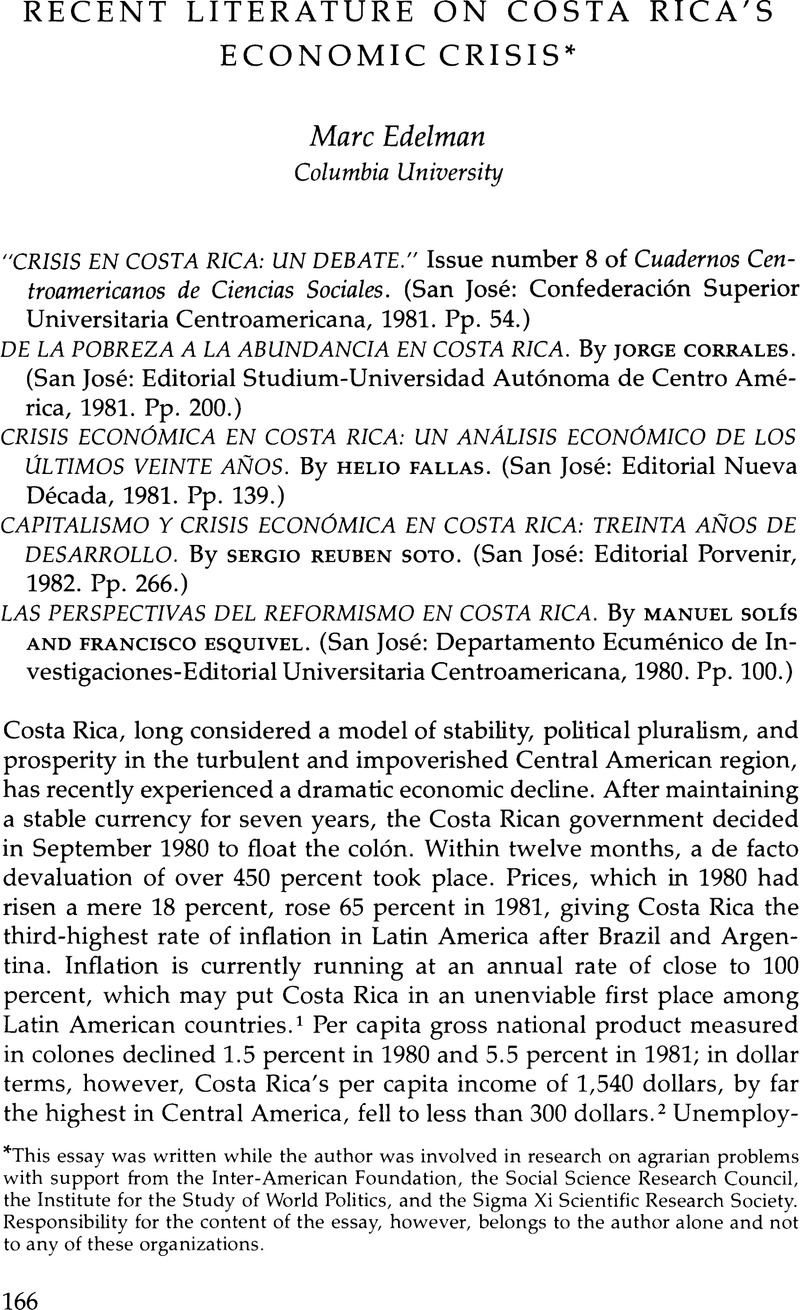Article contents
Recent Literature on Costa Rica's Economic Crisis
Review products
Published online by Cambridge University Press: 24 October 2022
Abstract

- Type
- Review Essays
- Information
- Copyright
- Copyright © 1983 by the University of Texas Press
Footnotes
This essay was written while the author was involved in research on agrarian problems with support from the Inter-American Foundation, the Social Science Research Council, the Institute for the Study of World Politics, and the Sigma Xi Scientific Research Society. Responsibility for the content of the essay, however, belongs to the author alone and not to any of these organizations.
References
Notes
1. Lidiette Brenes, “Política económica: la que más resiente el pueblo,” La Nación (San José), 7 May 1982, p. 1B; “Anuncia que inflación será 90 por ciento,” La Nación, 8 June 1982, p. 8A.
2. Lidiette Brenes, “La capacidad productiva disminuyó 3.5% en 1981,” La Nación, 13 April 1982, p. 4A; “Commentary: The Region,” Mesoamerica 1, no. 5 (May 1982): 2 (San José).
3. “Desempleo es de 9.2 por ciento,” La Nación, 25 April 1982, p. 6A.
4. Comercio Exterior de Costa Rica 1979 and 1980.
5. Brenes, “Política económica …”
6. On the 1940s and the civil war, see Manuel Rojas Bolaños, Lucha social y guerra civil en Costa Rica 1940-1948 (San José: Editorial Universitaria Centroamericana, 1979).
7. Real GNP growth fell from 5.5 percent in 1974 to 2.1 percent in 1975. Inflation rose from 4.6 percent in 1972, to 15.3 percent in 1973, to 30 percent in 1974. Solís and Esquivel, pp. 67-68.
8. The trade deficit in 1974 amounted to 63.4 percent of export earings, the highest level ever. This indicator fell to 40.7 percent in 1975, as a result of import restrictions and related measures, and to 29.9 percent in 1976 as coffee prices skyrocketed. Comercio Exterior de Costa Rica, 1974-76.
9. Ironically, this split became serious not during the Oduber PLN administration, but during the post-1980 economic deterioration, when the question of devaluation and exchange rate policies became the focus of conflict between agroexporters and industrialists. The most graphic manifestation of the disparate positions of these two groups has been the increasing divergence in the editorial policies of the two principal San José newspapers. La Nación now lobbies unabashedly for agroexport interests, while La Prensa Libre, which speaks for the industrialists, advocates strong controls to end the devaluation of the colón.
10. For example, see the articles in the special issue of Revista de Ciencias Sociales entitled “Movimientos sindicales en Costa Rica,” especially Carlos Alberto Abarca, “Luchas populares y organización obrera en Costa Rica (1950-1960),” Revista de Ciencias Sociales 15-16 (1978):34-54; also Diego Palma, “El Estado y la desmovilización social en Costa Rica,” Estudios Sociales Centroamericanos 27 (1980):183-206.
11. For example, Reuben asserts (p. 76) that the 1963 agricultural census did not measure farm units smaller than one manzana (0.69 hectare) and that therefore it is impossible to analyze this category of minifundio in the period 1963-73. Compare the publication of the Dirección General de Estadística y Censos, Censo agropecuario de 1963: fincas menores de una manzana y animales fuera de fincas (San José: DGEC, 1963). Similarly, Costa Rica is said to have entered the Central American Common Market in 1964, apparently to allow the 1964 industrial census to be used as a baseline for studying CACM-induced change. In fact, Costa Rica agreed to enter the CACM in 1962 and actually did so in 1963.
12. See William C. Thiesenhusen, “Reaching the Rural Poor and the Poorest: A Goal Unmet,” in International Perspectives in Rural Sociology, ed. Howard Newby (New York: John Wiley and Sons, 1978).
13. On CODESA, see Mylena Vega, El Estado costarricense de 1974 a 1978: CODESA y la fracción industrial (San José: Editorial Hoy, 1982).
14. Aaron Wildavsky, How to Limit Government Spending (Berkeley: University of California Press, 1980).
15. The articles, all in issue number 8 of Cuadernos Centroamericanos de Ciencias Sociales (1981), are: Carlos Araya Pochet, “La crisis en Costa Rica: algunos elementos históricos,” pp. 6-8; Francisco Esquivel, “Dimensión económica de la crisis en Costa Rica,” pp. 9-19; Manuel Solís, “Las perspectivas de la crisis en Costa Rica,” pp. 20-30; Manuel Rojas, “Crisis en Costa Rica. Algunos elementos para su comprensión,” pp. 31-37; and José Luis Vega Carballo, “Decadencia política y crisis económica en Costa Rica,” pp. 38-54.
- 3
- Cited by




